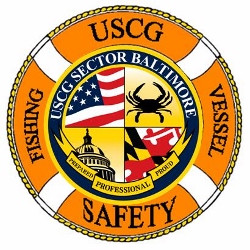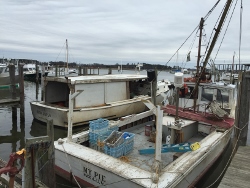Vessel Examinations
The Auxiliary provides vessel safety exams free of charge. There is no penalty for not passing an exam and you will be provided with information to help make you and your boat safer. For Recreational boats-Click on the find an Examiner link.
For non commercial, recreational vessel exams contact: Kirby Garland 301-537-4187 [email protected]
For Commercial Fishing and Uninspected Passenger Vessel (6-Pack) contact:Wendy Norwitz 240-305-3051 w[email protected]
WHAT WE’LL BE LOOKING FOR...
What will our vessel examiners be looking for when they conduct a voluntary vessel safety check of your boat? Basically, it’s the same list of equipment required by federal and state regulations. Here’s a rundown:
1. NUMBERING—Your boat registration number (such as MD-1234-LL) should be permanently attached to each side of the forward half of the boat. Letters and numbers must be plain, block-style digits at least three inches high, and in a color that contrasts with the background. A space or hyphen should separate the letters from the numbers. In Maryland, you’ll also need a small square-shaped state validation sticker that’s valid for the current year.
2. REGISTRATION OR DOCUMENTATION—Your papers should be up-to-date, on board and available. If you have a Coast-Guard-documented vessel, your number must be permanently marked on a visible part of the interior structure. In the case of documented vessels, you also must display your boat’s name and hailing port on the exterior hull in letters that are at least four inches high.
3. PERSONAL FLOTATION DEVICES—You must have one Coast-Guard-approved life jacket for each person on board. Children must have properly-fitted life jackets specially designed for them. In Maryland, children under four must have life jackets that also have a strap that is secured between the child’s legs, for extra safety. Also, boats 16 feet long and up must have one throwable device, such as a life-ring or cushion, immediately available (not stored in a plastic bag). On personal watercraft, operators must wear their life jackets while on their craft. High-impact life jackets are recommended for PWCs and water-skiing boats.
4. VISUAL DISTRESS SIGNALS—Recreational boats 16 feet and over must carry a minimum, of either: (a) three day and three night pyrotechnical devices; (b) one day non-pyrotechnic device (flag) and one night non-pyrotechnic device (auto SOS light); or (c) a combination of (a) and (b). Recreational boats shorter than 16 feet need only carry night visual distress signals when operating from sunset to sunrise.
5. FIRE EXTINGUISHERS—Fire extinguishers are required (a) if your boat has inboard engines; (b) if it has double-bottomed hulls that aren’t completely sealed or aren’t completely filled with flotation materials; (c) has closed living-spaces; (d) has closed stowage compartments that contain flammable materials; or (e) has permanently installed fuel tanks. Recreational boats that are shorter than 26 feet and are propelled by outboard motors are not required to carry fire extinguishers unless one of the conditions listed above—(a) through (e)—applies. Note: Fire extinguishers must be readily accessible and verified as serviceable.
MINIMUM NUMBER OF FIRE EXTINGUISHERS REQUIRED:
Boat length |
Without Fixed System | With Fixed System |
|
|
|
Less than 26 feet | one type B-1 | 0 |
26 feet to 39 feet | two type B-1 or one type B-2 | one type B-1 |
40 feet to 65 feet | three type B-1 or one type B-1 and one type B-2 | one type B-2 |
6. VENTILATION—Any boat that has a gasoline engine in a closed compartment and was built after August 1, 1980 must have a powered ventilation system. Those built before that date must have natural or powered ventilation. Boats with closed fuel tank compartments, and which were built after August 1, 1978, must display a certificate of compliance. Boats built before that date must have either natural or powered ventilation in the fuel-tank compartment.
7. BACKFIRE FLAME ARRESTER—All gasoline-powered inboard/outboard or inboard motor boats must be equipped with an approved backfire flame-control device.
8. SOUND-PRODUCING DEVICES—To comply with Navigation Rules and for signaling in case of distress, all boats must carry a sound-producing device (whistle, horn, siren, etc.) capable of a four-second blast audible of half a mile. Boats larger than 39.4 feet also must carry a bell.
9. NAVIGATION LIGHTS—All boats must be able to display navigation lights between sunset and sunrise and in conditions of reduced visibility. Boats 16 feet or longer must have properly installed, working navigation lights and an all-around anchor light which can be lighted independent of the red/green/white “running” lights.
10. POLLUTION PLACARD—Boats 26 feet and longer with a machinery compartment must display an oily waste “pollution” placard.
11. MARPOL TRASH PLACARD—Boats 26 feet and longer, operating in U.S. navigable waters, must display a MARPOL trash placard. Oceangoing boats 40 feet and longer also must have a written trash-disposal plan available onboard.
12. MARINE SANITATION DEVICE—Any installed toilet must be a Coast-Guard-approved defice. Overboard discharge outlets must be sealable.
13. NAVIGATION RULES—Boats 39.4 feet and longer must have on board a current copy of the Navigation Rules.
14. STATE AND LOCAL REQUIREMENTS—These requirements must be met before the Vessel Safety Check decal can be awarded. A boat must meet the requirements of the state in which it is being examined. For Maryland requirements, call up http://www.dnr.state.md.us/boating/pdfs/md_req_equip.pdf
15. OVERALL BOAT CONDITION—Included, but not limited to:
(a) Deck must be free of hazards and bilge must be clean. The boat must be free from fire hazards, in good overall condition, with bilges reasonably clean and visible hull structure generally sound. The use of automobile parts on boat engines is not acceptable. The engine horsepower must not exceed that shown on the capacity plate.
(b) Electrical and fuel systems. The electrical system must be protected by fuses or manual-reset circuit breakers. Switches and fuse panels must be protected from rain or water spray. Wiring must be in good condition, properly installed and with no exposed areas or deteriorated insulation. Batteries must be secured and terminals covered to prevent accidental arcing. If installed, the self-circling or kill-switch mechanism must be in proper working order. All PWCs require an operating self-circling or kill-switch mechanism.
Fuel systems and portable fuel tanks must be constructed of non-breakable material and be free of corrosion and leaks. All vents must be capable of being closed. The tank must be secured and have a vapor-tight, leak-proof cap. Each permanent fuel tank must be properly ventilated.
(c) Galley and heating systems. System and fuel tanks must be properly secured with no flammable materials nearby.

